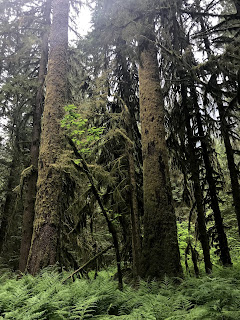Afterwards we moved onto a round table talk about everyone's projects, and the progress they've made on them. Karoline talked about how the waste audit is going. She reviewed the audit from 2013, and discovered that they used much more trash, such as aluminum cans and ziplock bags than we have this season. Karoline and most other students agreed it is most likely due to our changing society. She has also compared the data she collected from the begging of this field school season to this week, which showed students are bringing less waste in their lunches. Karoline mentioned how this is most likely due to peer pressure from others to bring less trash, because everyone can see when someone places something into the collection bag. Hopefully other field studies will start to do waste audits in the future, and reduce their overall contribution to landfills and climate change.
Over the next couple of weeks, I will be talking to people as they make more progress on their projects, and today I got the chance to talk with Rohan and Mitch about what they are working on. Mitch, as some of you already know if you have read previous posts, is working on the rock feature in the northwest corner of the McKenzie Creek site. He said for the past two weeks he has been clearing out foliage and moss from the area, and excavating the outside walls of the feature to determine its depth. He also mentioned that he has been focusing a lot of his time excavating the western wall, because it was completely buried in a diagonal wall of dirt. At first, Mitch didn't know if the wall had an end to it, or if it just continued into the creek close by, but he finally found a distinct end to the wall. The rough sketch below shows the east wall of the rock feature that was uncovered, with the dimensions and general shape of each rock.
 |
| Mitch's sketch of the east wall on the rock feature. |
 |
| Buttons in the McKenzie Creek collection. |
Next, Bob briefly talked about the difference between our cedar plank road and a corduroy road. Many people use the words interchangeably, but a corduroy road is a row of logs that create a path which is easier to travel on than the dirt or marsh below it.
 |
| Example of corduroy road. Source: Toronto Public Library |
After that quick conversation, Bob began his lecture on excavation procedures. We talked about what to do if we find an artifact in our unit or on the surface of the site, and the proper way to fill out artifact and level sheets. He also reviewed how to label a level bag when you find something in an excavation unit that is not classified as an artifact. Bob also mentioned that when the Seymour Valley Archaeology project is complete, there will be boxes of level bags to sort through, but he doesn't know what to do with all of the materials in the bags. If you have any suggestions on what to do with those materials, feel free to comment on the blog or message Bob on twitter here. Would it be smart to return the items back to the site? Please leave your suggestions below!
Bob also gave us a glimpse of what he is expecting to see on our final exam. Towards the end of the field season, we will be instructed to go to a site and draw a complete map of the area. He provided us with a key of some important symbols that he is expecting us to use on our maps, and said we will have time to practice with a group of people in the next two weeks. The final exam will be done individually, and by the time we reach the exam day, students should understand how to do everything themselves.
 |
| Standard archaeological map symbols. |
 |
| Layout of snacks that students organized to celebrate birthdays. |





















